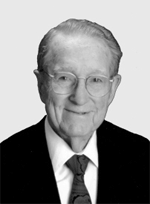Distinguished Engineer Citations

Duffer B. Crawford
Distinguished Engineer
2008
Degree
Chemical Engineering – 1941
Citation
At Time of Nomination in 2008
Duffer Crawford was born in 1919 and grew up in Haskell, TX. In 1937, he entered Texas Tech with the intention of becoming an aeronautical engineer until persuaded by his professor, Dr. A. G. Oberg, to major in chemical engineering, and thus began his memorable career. Upon Duffer’s graduation from Texas Tech in 1941, Dr. R. C. Goodwin, head of the engineering department and later president of Texas Tech, sponsored him to receive a scholarship to the University of Texas to pursue his master’s and doctorate degrees. In January 1943, Duffer left the University of Texas to assist his UT professor, Dr. Judson Swearingen, who had been commandeered in September 1942 by the Kellex Corp. in New York City to resolve problems related to the pumps and compressors required for gaseous diffusion uranium enrichment at the K–25 plant for the Oak Ridge, TN Atom Bomb Manhattan Project. While working on this assignment, Duffer developed the detailed design specifications of the pump seals which were used for the diffusion process. Gaseous diffusion was one of three processes that provided uranium–235 for the Hiroshima weapon "Little Boy." The design of that seal remains in use and is considered classified information today.
Duffer is proud to have been responsible for some important technical accomplishments, a few of which are listed here. He worked jointly with Carroll Claitor, Texas Tech graduate (BSChE ’41), to determine and publish The Thermodynamic Properties of Air (1946–47). For American Machine and Foundry, he was the first to solve the problem of achieving continuous onstream production of foam rubber by using a Teflon coating to minimize latex coagulation on equipment surfaces. Duffer developed an aluminum extrusion process for production of fuel rods and created a special welding procedure and remote operated vessel closure concept for the hydrogen bomb project at Savannah River, SC. Later, as a result of troubleshooting at an oxygen plant where leaking flanges had resulted in an explosion and caused the deaths of three workers, Duffer implemented design requirements converting cryogenic plants to utilize all–welded construction in order to prevent explosions from such leaks.
In response to the 1957 Soviet launch of Sputnik, the U.S. government approved funding for the production of liquid hydrogen and liquid oxygen for its space program. Then at Air Products & Chemicals, Duffer designed the world’s first commercial liquid hydrogen production facility for NASA, including working with various state transport commissions to develop over–the–road transport equipment and safety regulations.
Duffer worked for the M. W. Kellogg Company from 1960–1985. Early in 1961, he invented the process used in the world’s largest and most successful helium recovery plant for the National Helium Company in Liberal, KS as well as for the U.S. space program. That same process technology paved the way for M. W. Kellogg to become the leader in the design and construction of liquified natural gas (LNG) facilities worldwide. Based on Duffer’s LNG expertise, he has received awards from the governments of Algeria, Belgium, Kuwait, and Korea for his work. During 1966–1969, he was responsible for designing the cryogenic systems required for the world’s largest 107–ton superconducting magnet associated with the ZGS 12-foot bubble chamber at Argonne National Laboratory in IL.
Having always loved what he does, Duffer says, "I have never really worked a day in my life." Still in demand, he is an active consultant today.
It is a privilege and an honor for Texas Tech University’s College of Engineering to select this outstanding alumnus for recognition.
Duffer B. Crawford is declared a DISTINGUISHED ENGINEER.
Edward E. Whitacre Jr. College of Engineering
-
Address
100 Engineering Center Box 43103 Lubbock, Texas 79409-3103 -
Phone
806.742.3451 -
Email
webmaster.coe@ttu.edu
